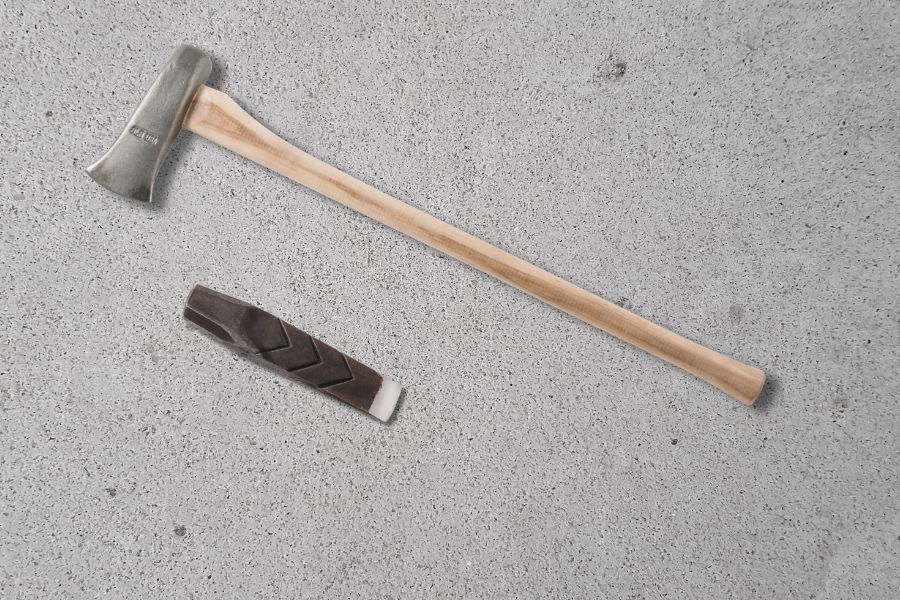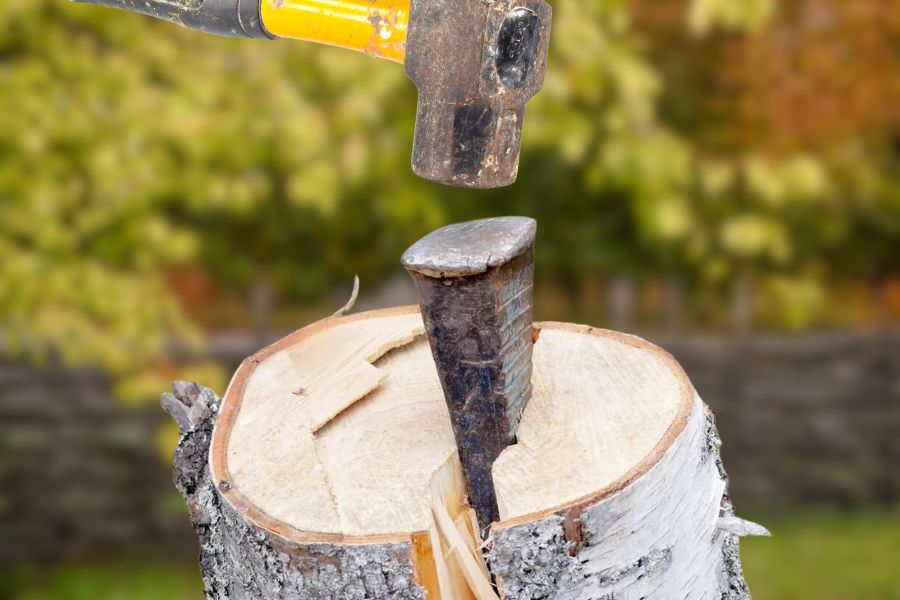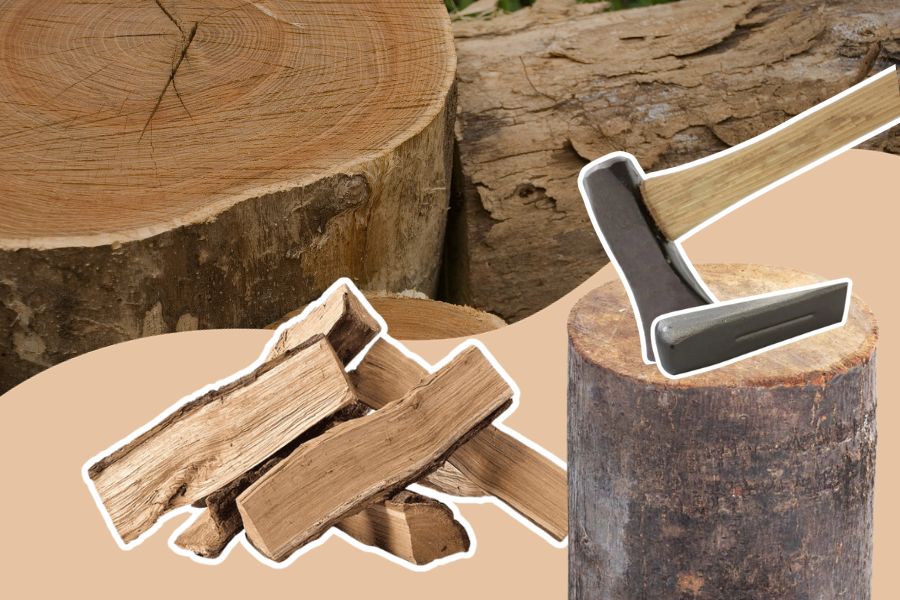Welcome to our handy guide on how to split wood with a wedge. You might think splitting is time-consuming, but it’s a breeze with the right tools, like a splitting wedge or a second wedge, and proven techniques. It’s more than just swinging a hammer’s handle.
We typically split along the existing crack, using a short wedge for a wide angle. Safety precautions are necessary – we’ll discuss things like wearing safety glasses and avoiding getting your tools stuck in the woods.
So, whether you’re cutting logs or splitting blocks, this guide will turn you into a wood-splitting pro. Stay tuned!
Introduction to Splitting Wood with a Wedge
Getting ready to split logs? You’re in the right spot! Splitting with a wedge isn’t just about force but also technique. First, you need the best tools: a metal wedge, a backup wedge for more power, and a sledgehammer.
Next, you’ll learn to strike at the same crack for efficient splitting. Tap the sharp edge of the wedge into the grain with your hammer. Use the portable inclined plane method for better leverage. Pile your cut logs and get ready to swing! Safety comes first, so keep that body clear when the blade flies.
Tools for the Task: Splitting Maul, Steel Wedge, and More

Ever wonder how lumberjacks split logs so easily? They use the right tools! You’ve got your splitting maul, like a super-ax for firewood. Then there’s the steel wedge, triangular, sharp, and sturdy. It’s a proven technique for efficient wood splitting.
When striking, aim to pound at one point with force. But remember, it’s not about strength; it’s about technique. If you pull it off right, your wedge will fly into the wood. The process may sound tricky, but it’s as easy as pie once you get the hang of it.
The Role of the Second Splitting Wedge
What’s better than one splitting wedge? Two wedges! That’s where the second splitting wedge, or the backup wedge, comes in. It gives you more force when you tap it into the log. Imagine it like having an extra hand that’s always ready to provide you with a boost.
The second one helps keep the splitting process going smoothly, making it super-efficient. Striking right and using your tools well, you’ll split logs like a pro in no time! Do you have any related questions about these tools? Don’t worry; we’ll answer them all.
Prepping Your Wood and Setting up the Chopping Block
Before you swing that hammer, set up the block and prep your wood. Start with choosing the correct length of the log. Remember, it’s not just about splitting; it’s about cutting it to the correct size.
Next, get your chopping block ready. This job isn’t for your regular ax; we’re talking big, solid blocks. Place the log on the block. Make sure it’s stable before you bring out the splitting wedge.
Safety glasses are on, your body is clear of the swing path, and you’re ready. Now, grip your sledgehammer, and let’s split some logs! With the proper process and the edge of your metal wedge, you’ll turn that firewood into perfect, even pieces in no time.
The Proper Technique: From First Split to the Last

Now we are splitting wedges. We’re ready to swing! The right way to split wood is to keep the splitting wedge and hammer in check. Here’s a quick step-by-step:
- Place the wedge on the top of the log.
- Gently tap the wedge with your hammer or sledgehammer to secure it into the wood.
- Once secure, give it a firm swing. Remember, it’s about technique, not just strength.
- The first split is always the sweetest, but keep going till the log is fully split.
Managing Larger Logs and Knotty Pieces
We’ve covered splitting logs, but what about the big, tough ones? Or the knotty pieces that the ax just can’t handle? Here’s where your wedge becomes your best friend. It can split wood no matter how large or knotty. Just aim for the weak points in the knots.
Give it a hefty swing with your sledgehammer, and watch as it splits even the toughest logs. Remember, every piece of wood has its breaking point, and finding it is the key to successful splitting.
Safety First: Protecting Yourself While Splitting Wood
You’re ready to split wood, but hold on! Let’s talk about safety. Splitting can be risky if you’re not careful. Always wear safety gear, even when you’re easily tapping a splitting wedge into a log. Your hands aren’t the only things at risk.
A rogue splinter can be more harmful than it looks. And remember, always maintain a safe distance when swinging your ax or sledgehammer.
Avoiding Common Mishaps: Stuck Wedges and Flying Splinters
Stuck wedges are a common problem when splitting. But don’t worry; we’ve got solutions! First, never try to force a stuck wedge out with another tool. Instead, try gently tapping the back of the wedge.
If that doesn’t work, use a backup wedge. As for flying splinters, they’re a part of the process. Just make sure to protect yourself with the right gear. Splitting is fun, but staying safe is priority number one!
Addressing Common Questions: From Log Length to Leverage
We get lots of questions about splitting wood, so let’s tackle some:
What’s the Best Log Length for Splitting?
Aim for logs that are 16-20 inches long.
How to Get the Most Leverage?
It’s all about the angle. Position your splitting wedge at a slight angle for the best results.
How to Tap the Wedge Efficiently?
Start gently tapping the wedge to embed it into the wood, then follow up with a stronger swing.
Dealing with Challenges: Cutting Large Diameter Blocks and More
Are you cutting large-diameter blocks? Don’t sweat it. It can be tricky even if you have a highly efficient tool like a splitting wedge or backup splitting wedges.
But remember, the key is to tap the blade at the right angle. It’s all about patience and technique. Bigger logs might take more swings, but you can easily split any log with the proper technique.
Conclusion: Mastering the Skill of Splitting Wood with a Wedge
And there you have it! We’ve journeyed from picking the right tool, like the splitting wedge and backup wedges, to mastering the skill of splitting. We’ve learned that it’s not just about force; technique plays a huge role.
We’ve seen how to gently tap a split wedge into a log, then give it a solid swing to split the wood. Always remember, safety comes first! Splitting can be fun and a great way to prepare firewood for the colder months.
Keep practicing, stay safe, and you’ll soon split like a pro. Now, pick up that blade and happy splitting!






